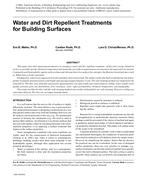Description
This paper describes important parameters in creating a water and dirt repellent treatment: surface free energy should be as low as possible and the chemical composition and molecule size of the treatment must correspond to the material to be treated. Commonly used hydrophobic agents such as silane and siloxane have low surface free energies, but fluorine-based polymers such as Teflon have a better potential.
Roofing tiles, which were supposed to be dirt repellent, have been tested. The surface of the tiles had a combination of a hydrophobic treatment and protrusions with height and spacing of approximately 25 µm. The self-cleaning method was inspired by the lotus flower. The tiles were naturally exposed for approximately two-and-a-half years and tested for soiling, water runoff, water uptake, porosity, pore size distribution, frost resistance, water vapor permeability, chemical composition, and topography.
The result was that the tiles with this self-cleaning method were neither hydrophobic nor self-cleaning. However, soiling was somewhat delayed. The tiles are no longer manufactured.
Citation: Thermal Performance of Exterior Envelopes of Whole Buildings IX
Product Details
- Published:
- 2004
- Number of Pages:
- 13
- File Size:
- 1 file , 6.1 MB
- Product Code(s):
- D-BldgsIX116
